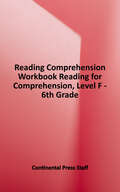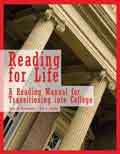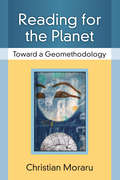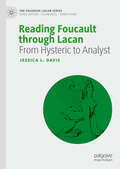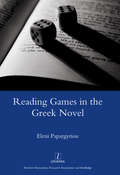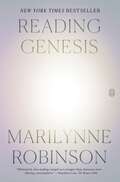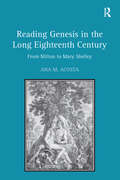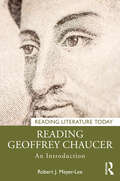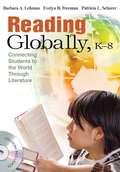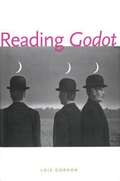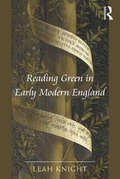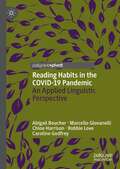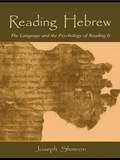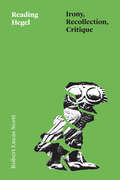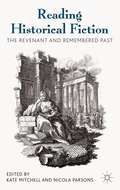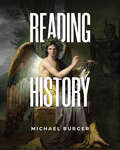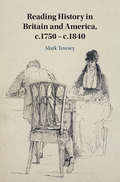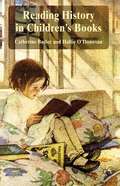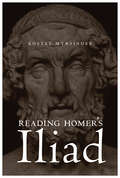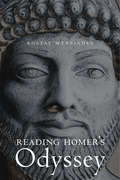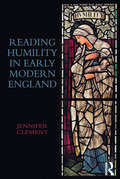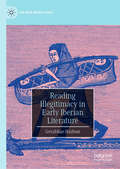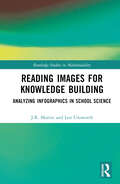- Table View
- List View
Reading For Comprehension: Level F
by Continental Press StaffHow does an IMAX movie work? With level F of Reading for Comprehension, your students will learn all about this kid-friendly topic and many more. This book for grade 6 students includes 46 high-interest, nonfiction articles with questions that reinforce key reading and writing skills commonly found on state tests. Multiple-choice questions test these reading skills: vocabulary, main idea and details, sequence, cause and effect, and inferences and conclusions. Students also answer open-ended questions to practice writing narrative text, descriptive text, persuasive text, and expository text.
Reading For Life: A Reading Manual For Transitioning Into College
by Faith Christiansen Judi QuimbyA study guide for: Tuesdays with Morrie The Last Lecture We Beat the Streets Learning from the Heart
Reading For The Planet: Toward A Geomethodology
by Christian MoraruIn his new book, Christian Moraru argues that post-Cold War culture in general and, in particular, the literature, philosophy, and theory produced since 9/11 foreground an emergent "planetary" imaginary--a "planetarism"--binding in unprecedented ways the world's peoples, traditions, and aesthetic practices. This imaginary, Moraru further contends, speaks to a world condition ("planetarity") increasingly exhibited by human expression worldwide. Grappling with the symptoms of planetarity in the arts and the human sciences, the author insists, is a major challenge for today's scholars--a challenge Reading for the Planet means to address. Thus, Moraru takes decisive steps toward a critical methodology--a "geomethodology"--for dealing with planetarism's aesthetic and philosophical projections. Here, Moraru analyzes novels by Joseph O'Neill, Mircea Cartarescu, Sorj Chalandon, Zadie Smith, Orhan Pamuk, and Dai Sijie, among others, as demonstration of his paradigm.
Reading Foucault Through Lacan: From Hysteric to Analyst (The Palgrave Lacan Series)
by Jessica L. DavisJacques Lacan and Michel Foucault are often cast as intellectual adversaries, their legacies marked by differences in method, lineages, and analytical priorities. Yet beneath their distinct projects lies a shared ambition: to decenter the Western conception of the subject while critically engaging with the notion of subjectivity in post-Kantian thought. This book examines Foucault’s critical project through the lens of Lacan’s theory of the four discourses, introduced in Seminar XVII: The Other Side of Psychoanalysis (1969-70). Divided into two parts, Reading Foucault through Lacan unfolds as a dialogue between the discourses of the Hysteric and the Analyst. Part I, “The Hysteric,” reframes Foucault’s genealogical critique from the early to mid-1970s as a form of hysterical questioning directed at Kant’s transcendental legacy and its aftermath. Through an exploration of how violence and embodied resistance interact in a discursive framework, Part I uncovers the epistemological fractures that mark the modern subject. Part II, “The Analyst,” examines Foucault’s redefinition of Kantian critique as a historically situated engagement with the present. Building on Lacan’s claim that analytic experience begins with the hystericization of discourse, this section views Foucault’s re-alignment with Kant as retroactively constituting the transformation from Hysteric to Analyst. Addressing themes such as parrhesia, transference, and the ethics of speaking, Part II examines discourse as a social link that transcends fixed identities to inhabit new modes of being. Drawing on newly available English translations of Foucault’s lectures and Lacan’s seminars, this book bridges two key trajectories in French thought and offers valuable insights for scholars of psychoanalysis, critical theory, and social philosophy.
Reading Games in the Greek Novel
by Eleni Papargyriou"How is play constituent in the formation of the Greek modernist novel? Reflecting competition with European and North American models as well as internal antagonism with more established literary genres in Greece, the novel after the 1930s employed playfulness as a means to demonstrate or even perform its novelty. Innovations unexpectedly came from the Greek periphery rather than Athens, and the Greek novel swiftly exchanged a passively understood realism for communicative patterns that actively involve the reader and educate him into bringing scraps of plot into a meaningful synthesis. Featuring key Greek authors such as Yannis Skarimbas, Stratis Tsirkas and Nikos Kachtitsis, this is a comprehensive and innovative study of Greek modernist prose fiction and the first of its kind to appear in English. Eleni Papargyriou is Lecturer in Modern Greek Literature at Kings College London."
Reading Genesis
by Marilynne RobinsonINSTANT NEW YORK TIMES BESTSELLEROne of our greatest novelists and thinkers presents a radiant, thrilling interpretation of the book of Genesis.For generations, the book of Genesis has been treated by scholars as a collection of documents by various hands, expressing different factional interests, with borrowings from other ancient literatures that mark the text as derivative. In other words, academic interpretation of Genesis has centered on the question of its basic coherency, just as fundamentalist interpretation has centered on the question of the appropriateness of reading it as literally true.Both of these approaches preclude an appreciation of its greatness as literature, its rich articulation and exploration of themes that resonate through the whole of Scripture. Marilynne Robinson’s Reading Genesis, which includes the full text of the King James Version of the book, is a powerful consideration of the profound meanings and promise of God’s enduring covenant with humanity. This magisterial book radiates gratitude for the constancy and benevolence of God’s abiding faith in Creation.
Reading Genesis in the Long Eighteenth Century: From Milton to Mary Shelley
by Ana M. AcostaIn a reassessment of the long-accepted division between religion and enlightenment, Ana Acosta here traces a tissue of readings and adaptations of Genesis and Scriptural language from Milton through Rousseau to Wollstonecraft and Mary Shelley. Acosta's interdisciplinary approach places these writers in the broader context of eighteenth-century political theory, biblical criticism, religious studies and utopianism. Acosta's argument is twofold: she establishes the importance of Genesis within utopian thinking, in particular the influential models of Milton and Rousseau; and she demonstrates that the power of these models can be explained neither by traditional religious paradigms nor by those of religion or philosophy. In establishing the relationship between biblical criticism and republican utopias, Acosta makes a solid case that important utopian visions are better understood against the background of Genesis interpretation. This study opens a new perspective on theories of secularization, and as such will interest scholars of religious studies, intellectual history, and philosophy as well as of literary studies.
Reading Geoffrey Chaucer: An Introduction (Reading Literature Today)
by Robert J. Meyer-LeeReading Geoffrey Chaucer: An Introduction offers students, general readers, and teachers an accessible series of essays on select works by Chaucer that emphasizes how those works’ deepest concerns and most fraught complexities remain urgently relevant in our present day. Each chapter connects Chaucer’s world with particular problems of our own, such as autocratic patriarchal social orders and geopolitical religious/racial conflict. Introducing modern critical approaches to those problems – gender studies and postcolonial theory, for example – each chapter provides in-depth discussion of how Chaucer explores their nature, implications, and consequences by way of his distinctive literary idiom. Texts covered include the General Prologue of the Canterbury Tales and the tales told by the Knight, Miller, Man of Law, Wife of Bath, Pardoner, and Prioress and the House of Fame, Legend of Good Women, and Troilus and Criseyde. Each chapter is self-contained, supplying essential backgrounds along with full summaries of the works under discussion. But the book is also criss-crossed with recurrent inquiries, which collectively trace some of the most characteristic qualities of Chaucer’s writing. With its unusual combination of breadth and depth, this introduction to Chaucer helps readers at all levels of familiarity appreciate why his work continues to matter.
Reading Globally, K-8: Connecting Students to the World Through Literature
by Barbara A. Lehman Evelyn B. Freeman Patricia Louise ScharerThe authors make the case for why it is necessary to be globally literate and multiculturally aware in today's shrinking world, and they provide the tools teachers need to incorporate appropriate reading selections into elementary and middle school classrooms. By using books from or about other countries, teachers empower students to view the world in a more positive manner, enriching and broadening their students' lives, and ultimately preparing them for life in a global economy and culture. This reader-friendly resource guides teachers and reading program coordinators in selecting quality books for their classrooms, incorporating global literature into different content areas, and facilitating the discussions that follow.
Reading Godot
by Lois G. GordonWaiting for Godot has been acclaimed as the greatest play of the twentieth century. It is also the most elusive: two lifelong friends sing, dance, laugh, weep, and question their fate on a road that descends from and goes nowhere. Throughout, they repeat their intention "Let's go," but this is inevitably followed by the direction "(They do not move. ). " This is Beckett's poetic construct of the human condition. Lois Gordon, author of The World of Samuel Beckett, has written a fascinating and illuminating introduction to Beckett's great work for general readers, students, and specialists. Critically sophisticated and historically informed, it approaches the play scene by scene, exploring the text linguistically, philosophically, critically, and biographically. Gordon argues that the play portrays more than the rational mind's search for self and worldly definition. It also dramatizes Beckett's insights into human nature, into the emotional life that frequently invades rationality and liberates, victimizes, or paralyzes the individual. Gordon shows that Beckett portrays humanity in conflict with mysterious forces both within and outside the self, that he is an artist of the psychic distress born of relativism.
Reading Green in Early Modern England
by Leah KnightGreen in early modern England did not mean what it does today; but what did it mean? Unveiling various versions and interpretations of green, this book offers a cultural history of a color that illuminates the distinctive valences greenness possessed in early modern culture. While treating green as a panacea for anything from sore eyes to sick minds, early moderns also perceived verdure as responsive to their verse, sympathetic to their sufferings, and endowed with surprising powers of animation. Author Leah Knight explores the physical and figurative potentials of green as they were understood in Renaissance England, including some that foreshadow our paradoxical dependence on and sacrifice of the green world. Ranging across contexts from early modern optics and olfaction to horticulture and herbal health care, this study explores a host of human encounters with the green world: both the impressions we make upon it and those it leaves with us. The first two chapters consider the value placed on two ways of taking green into early modern bodies and minds-by seeing it and breathing it in-while the next two address the manipulation of greenery by Orphic poets and medicinal herbalists as well as grafters and graffiti artists. A final chapter suggests that early modern modes of treating green wounds might point toward a new kind of intertextual ecology of reading and writing. Reading Green in Early Modern England mines many pages from the period - not literally but tropically, metaphorically green - that cultivate a variety of unexpected meanings of green and the atmosphere and powers it exuded in the early modern world.
Reading Habits in the COVID-19 Pandemic: An Applied Linguistic Perspective
by Marcello Giovanelli Robbie Love Chloe Harrison Abigail Boucher Caroline GodfreyThis book presents and analyses the results of the Lockdown Library Project survey, using a range of quantitative and qualitative approaches to provide a unique insight into the ways in which the first UK COVID-19 lockdown affected public reading habits. The authors begin by outlining the background to the study, the research methodology and design, and an overview of the headlines of the data, before going on to survey the literature on the relationship between pandemics, literature (especially the role played by genre and popular fiction) and reading habits. They then examine how participants reported that the lockdown period had affected the amount that they read; how they accessed books and discussed their reading with others; the use of reading as a coping strategy; and returning to re-read books that offered familiarity, reliability, and nostalgia. Finally, the concluding chapter brings together the overall findings of the project and briefly outlines future work in the field. This book will be of interest to academics in fields such as literary and genre studies, applied linguistics, corpus linguistics, stylistics, health humanities, and sociology, as well as practitioners working in education, in bibliotherapy, and in libraries.
Reading Hebrew: The Language and the Psychology of Reading It
by Joseph ShimronOver the last two decades, the study of languages and writing systems and their relationship to literacy acquisition has begun to spread beyond studies based mostly on English language learners. As the worldwide demand for literacy continues to grow, researchers from different countries with different language backgrounds have begun examining the connection between their language and writing system and literacy acquisition. This volume is part of this new, emerging field of research. In addition to reviewing psychological research on reading (the author's specialty), the reader is introduced to the Hebrew language: its structure, its history, its writing system, and the issues involved in being fluently literate in Hebrew.Chapters 1-4 introduce the reader to the Hebrew language and word structure and focuses on aspects of Hebrew that have been specifically researched by experimental cognitive psychologists. The reader whose only interest is in the psychological mechanisms of reading Hebrew may be satisfied with these chapters.Chapters 5-8 briefly surveys the history of the Hebrew language and its writing system, the origin of literacy in Hebrew as one of the first alphabetic systems, and then raises questions about the viability (or possibility) of having full-scale literacy in Hebrew. Together, the two sets of chapters present the necessary background for studying the psychology of reading Hebrew and literacy in Hebrew.This volume is appropriate for anyone interested in comparative reading and writing systems or in the Hebrew language in particular. This includes linguists, researchers, and graduate students in such diverse fields as cognitive psychology, psycholinguistics, literacy education, English as a second language, and communication disorders.
Reading Hegel: Irony, Recollection, Critique (Thinking Literature)
by Robert Lucas ScottRetrieves Hegelian speculative experience for literary theory. The relationship between Hegel and literary theory has for a long time been both contested and paradoxical. On the one hand, “theory” is often skeptical of all that Hegel ostensibly stood for: idealism, systematicity, and identity at the expense of difference. Yet, in spite of itself, literary theory is taken to owe a profound debt to Hegel’s philosophy. Robert Lucas Scott’s book complicates this account and argues that literary theory has made the mistake of abstracting Hegel’s thought from its more dynamic presentation in Hegel’s writings, reducing “Hegel” to a series of propositions or positions. Literary theory, Scott argues, misses what is perhaps the greatest innovation of Hegel’s philosophy: a presentation of experience that begins precisely by setting aside all preconceptions or prior assumptions. It is on this point that Hegel’s philosophy itself approaches literature: its content cannot be simply abstracted from the singular experience of reading it. Only through a mode of reading alive to speculative experience can literary theory become truly Hegelian. Scott’s exposition of Hegel offers a model of reading with relevance beyond philosophy: one that is critical without pretensions of mastery and detachment and that honors the singularity of the reading experience without succumbing to the subjectivism of the “postcritical.” The book also includes engagements with the work of Luther, Kant, Marx, Gillian Rose, Fredric Jameson, Robert Brandom, Catherine Malabou, and more in its recovery of Hegel’s thought for a critical understanding of our time.
Reading Herodotus: A Guided Tour through the Wild Boars, Dancing Suitors, and Crazy Tyrants of The History
by Debra HamelHamel takes us on a delightful, audacious romp through The History of the Persian Wars.Debra Hamel’s book is a lively introduction to The History of the Persian Wars, Herodotus's account of Persia's expansion under four kings—Cyrus, Cambyses, Darius, and Xerxes—and its eventual collision with the city-states of Greece. The History can be a long slog for modern readers, but it is full of salacious tales about sex, violent death, divine prophecies, and cannibals. Following the structure of the original work, Hamel leads the reader through a colorful tour of the central stories that compose The History. She highlights the more interesting and important parts of the story while providing readers who are new to Herodotus with the background information necessary to appreciate the author’s wide-ranging subject matter. At once academic and cheeky, the experience of this book is like reading Herodotus while simultaneously consulting a history of Greece and a scholarly commentary on the text.
Reading Historical Fiction
by Kate Mitchell Nicola ParsonsThis collection examines the intersection of historical recollection, strategies of representation, and reading practices in historical fiction from the eighteenth century to today. In shifting focus to the agency of the reader and taking a long historical view, the collection brings a new perspective to the field of historical representation.
Reading History
by Michael BurgerHistory students read a lot. They read primary sources. They read specialized articles and monographs. They sometimes read popular histories. And they read textbooks. Yet students are beginners, and as beginners they need to learn the differences among various kinds of readings – their natures, their challenges, and the unique expectations one needs to bring to each of them. Reading History is a practical guide to help students read better. Uniquely designed with the author’s engaging explanations in the margins, the book describes primary sources across various genres, including documents of practice, treatises, and literary works, as well as secondary sources such as textbooks, articles, and monographs. An appendix contains tips and questions for reading primary or secondary sources. Full of practical advice and hands-on training that allows students to be successful, Reading History will cultivate a wider appreciation for the discipline of history.
Reading History in Britain and America, c.1750–c.1840
by Mark TowseyThe period between c.1750 and c.1840 is popularly known for the rise of the novel, yet historical works by Enlightenment writers, including David Hume, Edward Gibbon and William Robertson, were some of its most commercially successful books. Moving beyond the range of previous studies that have sought to explain this success by focussing on publishers, writers and their ideas, Mark Towsey's study is the first to focus on the reading audiences themselves. Drawing on a variety of sources including marginalia, letters, diaries and commonplace books, this lively book reveals why histories were so widely read, and shows how they were used by readers across the English-speaking world to make sense of social upheaval at home and revolution abroad. In doing so, it marks a major addition to the history of reading, shedding fascinating new light on how readers interpreted books in the past.
Reading History in Children�s Books
by Catherine Butler Hallie O�donovanThis book offers a critical account of historical books about Britain written for children, including realist novels, non-fiction, fantasy and alternative histories. It also investigates the literary, ideological and philosophical challenges involved in writing about the past, especially for an audience whose knowledge of history is often limited.
Reading Homer's Iliad
by Kostas MyrsiadesWe still read Homer’s epic the Iliad two-and-one-half millennia since its emergence for the questions it poses and the answers it provides for our age, as viable today as they were in Homer’s own times. What is worth dying for? What is the meaning of honor and fame? What are the consequences of intense emotion and violence? What does recognition of one’s mortality teach? We also turn to Homer’s Iliad in the twenty-first century for the poet’s preoccupation with the essence of human life. His emphasis on human understanding of mortality, his celebration of the human mind, and his focus on human striving after consciousness and identity has led audiences to this epic generation after generation. This study is a book-by-book commentary on the epic’s 24 parts, meant to inform students new to the work. Endnotes clarify and elaborate on myths that Homer leaves unfinished, explain terms and phrases, and provide background information. The volume concludes with a general bibliography of work on the Iliad, in addition to bibliographies accompanying each book’s commentary.
Reading Homer’s Odyssey
by Kostas MyrsiadesHomer’s Odyssey is the first great travel narrative in Western culture. A compelling tale about the consequences of war, and about redemption, transformation, and the search for home, the Odyssey continues to be studied in universities and schools, and to be read and referred to by ordinary readers. Reading Homer’s Odyssey offers a book-by-book commentary on the epic’s themes that informs the non-specialist and engages the seasoned reader in new perspectives. Among the themes discussed are hospitality, survival, wealth, reputation and immortality, the Olympian gods, self-reliance and community, civility, behavior, etiquette and technology, ease, inactivity and stagnation, Penelope’s relationship with Odysseus, Telemachus’ journey, Odysseus’ rejection of Calypso’s offer of immortality, Odysseus’ lies, Homer’s use of the House of Atreus and other myths, the cinematic qualities of the epic’s structure, women’s role in the epic, and the Odyssey’s true ending. Footnotes clarify and elaborate upon myths that Homer leaves unfinished, explain terms and phrases, and provide background information. The volume concludes with a general bibliography of work on the Odyssey, in addition to the bibliographies that accompany each book’s commentary. Published by Bucknell University Press. Distributed worldwide by Rutgers University Press.
Reading Humility in Early Modern England
by Jennifer ClementWhile humility is not especially valued in modern Western culture, Jennifer Clement argues here, it is central to sixteenth- and seventeenth-century understandings of Christian faith and behavior, and is vital to early modern concepts of the self. As this study shows, early modern literary engagements with humility link it to self-knowledge through the practice of right reading, and make humility foundational to any proper understanding of human agency. Yet humility has received little critical interest, and has often been misunderstood as a false virtue that engenders only self-abjection. This study offers an overview of various ways in which humility is discussed, deployed, or resisted in early modern texts ranging from the explicitly religious and autobiographical prose of Katherine Parr and John Donne, to the more politically motivated prose of Queen Elizabeth I and the seventeenth-century reformer and radical Thomas Tryon. As part of the wider 'turn to religion' in early modern studies, this study seeks to complicate our understanding of a mainstream early modern virtue, and to problematize a mode of critical analysis that assumes agency is always defined by resistance.
Reading Illegitimacy in Early Iberian Literature (The New Middle Ages)
by Geraldine HazbunReading Illegitimacy in Early Iberian Literature presents illegitimacy as a fluid, creative, and negotiable concept in early literature which challenges society’s definition of what is acceptable. Through the medieval epic poems Cantar de Mio Cid and Mocedades de Rodrigo, the ballad tradition, Cervantes’s Novelas ejemplares, and Lope de Vega’s theatre, Geraldine Hazbun demonstrates that illegitimacy and legitimacy are interconnected and flexible categories defined in relation to marriage, sex, bodies, ethnicity, religion, lineage, and legacy. Both categories are subject to the uncertainties and freedoms of language and fiction and frequently constructed around axes of quantity and completeness. These literary texts, covering a range of illegitimate figures, some with an historical basis, demonstrate that truth, propriety, and standards of behaviour are not forged in the law code or the pulpit but in literature’s fluid system of producing meaning.
Reading Images for Knowledge Building: Analyzing Infographics in School Science (Routledge Studies in Multimodality)
by Len Unsworth J.R. MartinThis innovative volume provides a new analytic framework for understanding how meaning-making resources are deployed in images designed for knowledge building in school science. The framework enables analyses of science images from the perspectives of both their complexity and recognizability. Complexity deals with the technical and abstract knowledge of school science (technicality), evaluative dispositions in relation to that knowledge (iconization) and the condensation of the technical and dispositional meanings as ‘synoptic eyefuls’ in discipline-specific infographics (aggregation). Recognizability concerns the relationship between the appearance of phenomena in reality and the reconfiguration of this reality in images (congruence), the perceptibility or discernibility of the features and contexts of phenomena in images (explicitness), and how images engage their viewers (affiliation). The framework is illustrated by more than 100 images in colour in the e-book and black and white in the paper version and will inform research into multimodal literacy pedagogy that incorporates an understanding of the role of images in the teaching and learning of school science. This book will be of particular interest to scholars in multimodality, semiotics, literacy education and science education.
